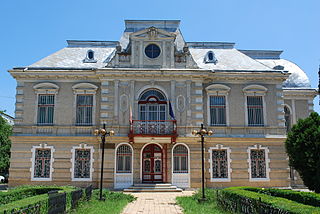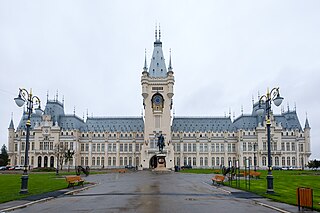
Iași, also referred to mostly historically as Jassy, is the second largest city in Romania and the seat of Iași County. Located in the historical region of Moldavia, it has traditionally been one of the leading centres of Romanian social, cultural, academic and artistic life. The city was the capital of the Principality of Moldavia from 1564 to 1859, then of the United Principalities from 1859 to 1862, and the capital of Romania from 1916 to 1918.

Iași County is a county (județ) of Romania, in Western Moldavia, with the administrative seat at Iași. It is the most populous county in Romania, after the Municipality of Bucharest.

Roman is a city located in the central part of Western Moldavia, a traditional region of Romania. It is located 46 km east of Piatra Neamț, in Neamț County at the confluence of the rivers Siret and Moldova.

The Voroneț Monastery is a medieval monastery in the Romanian village of Voroneț, now a part of the town Gura Humorului. It is one of the famous painted monasteries from southern Bukovina, in Suceava County. The monastery was constructed by Stephen the Great in 1488 over a period of 3 months and 3 weeks to commemorate the victory at Battle of Vaslui. Often known as the "Sistine Chapel of the East", the frescoes at Voroneț feature an intense shade of blue known in Romania as "Voroneț blue."

The Palace of Culture is an edifice located in Iași, Romania. The building served as Administrative and Justice Palace until 1955, when its destination was changed, being assigned to the four museums nowadays united under the name of Moldavia National Museum Complex. Also, the building houses the Cultural Heritage Conservation-Restoration Centre, and hosts various exhibitions and other events.

The Bistrița Monastery is a Romanian Orthodox monastery located 8 km west of Piatra Neamț. It was dedicated in 1402, having as original ctitor the Moldavian Voivode Alexandru cel Bun whose remains are buried here.

Belcești is a commune in Iași County, Western Moldavia, Romania, situated on the Bahlui River 44 km from Iași. One of the county's largest communes, with a population of 10,555 in 2011, it is composed of six villages: Belcești, Liteni, Munteni, Satu Nou, Tansa, and Ulmi.

Mera is a commune in Romania. It is located in Vrancea County. It is composed of five villages: Livada, Mera, Milcovel, Roșioara, and Vulcăneasa.

Mănăstirea Trei Ierarhi is a seventeenth-century monastery located in Iași, Romania. The monastery is listed in the National Register of Historic Monuments and included on the tentative list of UNESCO World Heritage Sites.

The Golia Monastery is a Romanian Orthodox monastery located in Iaşi, Romania. The monastery is listed in the National Register of Historic Monuments. In 2012, the conservation of the Monastery was awarded the European Union Prize for Cultural Heritage / Europa Nostra Award.

The Bârnova Monastery is a Romanian Orthodox monastery located in Bârnova, Iași metropolitan area, Moldavia, Romania.

The Galata Monastery is a Romanian Orthodox monastery for nuns, founded at the end of the sixteenth century by Moldavian Voivode Petru Şchiopul, in the west of Iaşi, Romania. The monastery is located on the top of Galata Hill, and can be easily observed from different locations of Iasi. The church, surrounded by walls with loopholes and provided with a bell tower at the entrance, looks like a fortress, often serving as a place of defense and sometimes as a royal residence. Near the church on the hill, are places that provide panoramic views over the city.

The Cetățuia Monastery is a Romanian Orthodox monastery located in Iași, Romania. The monastery is listed in the National Register of Historic Monuments.

The Frumoasa Monastery is a Romanian Orthodox monastery located in Iaşi, Romania.

The Hlincea Monastery is a Romanian Orthodox monastery in Ciurea, Iaşi metropolitan area, Romania.
Moldovenesc style or Moldavian architectural style is a type of architecture developed in Moldavia during the 14th through 19th centuries.

The Hadâmbu Monastery is a Romanian Orthodox monastery located in Schitu Hadâmbului, Iași County, Romania.

The Zlataust Church is a Romanian Orthodox church located at 5 Zlataust Road in Iași, Romania. It is dedicated to Saints John Chrysostom and Theodore of Amasea.

Saint Sabbas Church is a Romanian Orthodox church located at 44 Costache Negri Street in Iași, Romania. It is dedicated to Saint Sabbas the Sanctified.

Popăuţi Monastery is a monastery located in Botoșani, Romania, on Ştefan cel Mare Street no. 41, near the train station. It was founded in 1496 by the voivode Stephen the Great (1457-1504).





















